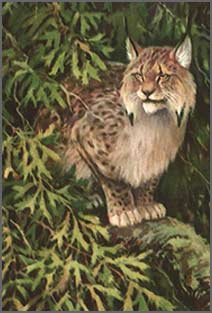Biosphere Contents
4. Interdependence
The snowshoe hare and the lynx may exist in dynamic equilibrium

The relationship between snowshoe hare (Lepus americanus) and Canada lynx (Lynx Canadensis) populations has been much discussed by ecologists as an example of predator-prey dynamics. The snowshoe hare is the main prey of the lynx, and populations of both species have been estimated using records of the number of pelts collected by the Hudson Bay Company since the early nineteenth century. The populations appear to follow a classic 8-11 year cycle of oscillations, with snowshoe hare numbers peaking, then crashing due to predation by lynx. After a short lag the lynx population then crashes, as individuals die of starvation. This allows the snowshoe hare population to recover, followed by recovery of the lynx population, completing the cycle. This appears to be a dynamic equilibrium, characterised by oscillating populations of both species. Recent research though has shown that these oscillations may have more complex causes, with exposure to stress from predators reducing the reproductive success of snowshoe hares, in addition to the lethal effects of predation (Sheriff 2009).
What is the relationship between the snowshoe hare and the lynx?